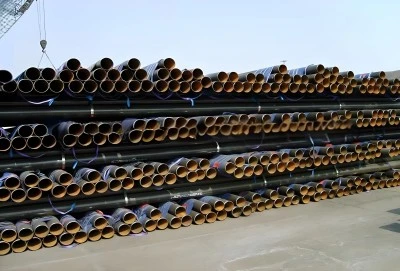In the world of steel pipes, API 5L X42 is a widely recognized and utilized grade, known for its balanced combination of strength and versatility. This article delves into the yield strength of API 5L X42 steel pipe, its relationship to tensile strength, and how it performs under various operating conditions. Whether you're an engineer, contractor, or simply interested in steel pipe specifications, this comprehensive guide will provide valuable insights into the characteristics of API 5L X42 pipe.
|
|
|
What is the yield strength of API 5L X42 steel pipe?
The yield strength of API 5L X42 steel pipe is a crucial factor in determining its performance and suitability for various applications. By definition, API 5L X42 pipe has a minimum yield strength of 42,100 psi (290 MPa). This specification is what gives the X42 grade its name, with the "42" indicating the minimum yield strength in thousands of psi.
Yield strength is a measure of the stress at which a material begins to deform plastically. For API 5L X42 pipe, this means it can withstand pressures up to 42,100 psi before permanent deformation occurs. This property is essential in pipeline design and operation, as it determines the maximum allowable operating pressure (MAOP) of the pipe.
It's important to note that while 42,100 psi is the minimum yield strength, actual values can be higher. Manufacturers often aim for a yield strength slightly above this minimum to ensure compliance with API specifications. This safety margin helps account for potential variations in material properties and ensures the pipe meets or exceeds performance requirements in real-world applications.
The yield strength of API 5L X42 pipe makes it suitable for a wide range of applications, particularly in low to medium-pressure systems. It's commonly used in oil and gas pipelines, water transmission lines, and various industrial piping systems where moderate strength is required.
How does API 5L X42 yield strength relate to tensile strength?
Understanding the relationship between yield strength and tensile strength is crucial for comprehending the overall mechanical properties of API 5L X42 pipe. While yield strength indicates the point at which the material begins to deform plastically, tensile strength represents the maximum stress the material can withstand before failure.
For API 5L X42 pipe, the minimum tensile strength is specified as 60,200 psi (415 MPa). This creates a yield-to-tensile ratio of approximately 0.70, which is typical for this grade of steel pipe. This ratio is important because it provides insight into the pipe's behavior under stress:
- A lower ratio (closer to 0.5) indicates a more ductile material that can undergo significant plastic deformation before failure.
- A higher ratio (closer to 1.0) suggests a material that is stronger but potentially less ductile.
The yield-to-tensile ratio of API 5L X42 pipe strikes a balance between strength and ductility. This balance is beneficial in many applications as it provides:
- Sufficient strength to withstand operating pressures
- Enough ductility to resist brittle fracture and accommodate some degree of deformation
- Good weldability, which is crucial for pipeline construction and maintenance
It's worth noting that while the minimum yield and tensile strengths are specified, the actual values can vary within a range. Manufacturers may produce pipes with strengths exceeding these minimums, but they must stay within the specified ranges to maintain the desired balance of properties.
How does API 5L X42 yield strength change under different operating conditions?
The yield strength of API 5L X42 pipe, while specified under standard conditions, can be influenced by various operating conditions. Understanding these influences is crucial for ensuring the safe and efficient operation of pipeline systems. Let's explore how different factors can affect the yield strength:
1. Temperature Effects: Temperature has a significant impact on the yield strength of steel pipes. Generally, as temperature increases, yield strength decreases. For API 5L X42 pipe:
- At low temperatures (below 0°C), the yield strength may increase slightly, but the pipe can become more susceptible to brittle fracture.
- At elevated temperatures (above 100°C), the yield strength begins to decrease. This reduction becomes more pronounced as temperatures rise further.
Engineers must consider these temperature effects when designing pipelines that operate in extreme environments, such as arctic regions or high-temperature industrial applications.
2. Strain Rate: The rate at which stress is applied to the pipe can affect its apparent yield strength. Under rapid loading conditions (high strain rates), such as those experienced during sudden pressure changes or seismic events, the apparent yield strength of API 5L X42 pipe may increase slightly. However, this effect is generally less pronounced in lower-grade steels like X42 compared to higher-grade steels.
3. Cyclic Loading: In applications where the pipe is subjected to repeated loading and unloading cycles, fatigue can impact the material's properties. While the initial yield strength remains unchanged, the accumulation of microscopic damage over time can lead to failure at stresses below the original yield strength. This phenomenon underscores the importance of proper fatigue analysis in pipeline design, especially for applications with frequent pressure fluctuations.
4. Environmental Factors: Corrosive environments can significantly impact the performance of API 5L X42 pipe. While corrosion doesn't directly affect the yield strength of the base material, it can reduce the effective wall thickness of the pipe, leading to a decrease in its pressure-bearing capacity. Hydrogen embrittlement, which can occur in certain environments, may also alter the mechanical properties of the steel, potentially reducing its ductility and toughness.
5. Residual Stresses: Manufacturing processes, installation procedures, and welding can introduce residual stresses in the pipe. These stresses can effectively lower the apparent yield strength in certain areas of the pipe. Proper heat treatment and stress-relief procedures during manufacturing and installation can help mitigate these effects.
It's crucial for engineers and operators to consider these factors when designing and operating pipeline systems using API 5L X42 pipe. While the specified minimum yield strength provides a baseline for performance, the actual behavior of the pipe in service can be influenced by a complex interplay of these various factors.
Regular inspection and monitoring of pipelines are essential to ensure that the pipe continues to perform within safe operating parameters throughout its service life. Advanced techniques such as stress analysis, corrosion monitoring, and non-destructive testing play crucial roles in maintaining the integrity of pipeline systems constructed with API 5L X42 pipe.
Contact Longma
For engineers and operators working with X42 pipe, a thorough understanding of these factors is essential. Proper design considerations, regular inspections, and ongoing monitoring are key to ensuring the safe and efficient operation of pipeline systems constructed with this grade of steel pipe.
If you're considering API 5L X42 pipe for your next project or simply want to learn more about its properties and applications, don't hesitate to reach out to the experts. At Longma Group, we specialize in manufacturing high-quality API 5L steel pipes, including the X42 grade. Our team of professionals can provide you with detailed information, technical support, and customized solutions for your specific needs. Contact us today at info@longma-group.com to discuss how pipe can benefit your project.














